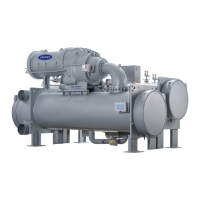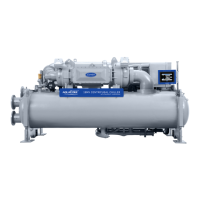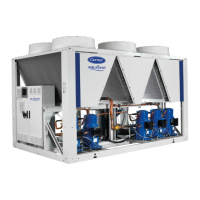17
Free-Standing Starters/VFDs
In addition to unit-mounted starters the 19XR product line of-
fers free-standing starter types of Across the Line, Solid State,
Auto-Transformer and VFD. 19XR6-7 are only offered with
free-standing starters/VFDs. For free-standing starters/VFDs
refer to job submittal drawings.
CONTROLS
Definitions
ANALOG SIGNAL
An analog signal varies in proportion to the monitored source. It
quantifies values between operating limits. (Example: A tem-
perature sensor is an analog device because its resistance chang-
es in proportion to the temperature, generating many values.)
DISCRETE SIGNAL
A discrete signal is a 2-position representation of the value of a
monitored source. (Example: A switch produces a discrete signal
indicating whether a value is above or below a set point or bound-
ary by generating an on/off, high/low, or open/closed signal.)
General
The 19XR centrifugal liquid chiller contains a microprocessor-
based control center that monitors and controls all operations of
the chiller. The microprocessor control system matches the cool-
ing capacity of the chiller to the cooling load while providing
state-of-the-art chiller protection. The system controls cooling
load within the set point plus the deadband by sensing the leaving
chilled water or brine temperature and regulating the inlet guide
vane via a mechanically linked actuator motor. The guide vane is a
variable flow pre-whirl assembly that controls the refrigeration ef-
fect in the cooler by regulating the amount of refrigerant vapor
flow into the compressor. An increase in guide vane opening in-
creases capacity. A decrease in guide vane opening decreases ca-
pacity. Additionally if a unit is equipped with VFD then the con-
troller will control both compressor speed and guide vane for opti-
mum efficiency at a particular load. The microprocessor-based
control center protects the chiller by monitoring the digital and an-
alog inputs and executing capacity overrides or safety shutdowns,
if required.
PIC 6 System Components
The chiller control system is called the PIC 6 (Product Integrated
Control 6). See Table 1. As with previous PIC versions, the PIC
6 system controls the operation of the chiller by monitoring all
operating conditions. The PIC 6 control system can diagnose a
problem and let the operator know what the problem is and what
to check. It positions the guide vanes to maintain leaving chilled
water temperature. It interfaces with auxiliary equipment such as
pumps and cooling tower fans to turn them on when required. It
continually checks all safeties to prevent unsafe operating condi-
tions. It also regulates the oil heater while the compressor is off
and regulates the envelope control (HGBP) and any other auto-
matic valves, if installed. The PIC 6 controls provide critical pro-
tection for the compressor motor and control the motor starter.
Table 1 — Major PIC 6 Components and
Panel Locations
NOTE: For detailed information about the PIC 6 HMI (human
machine interface), see the 19XR with PIC 6 Controls Opera-
tion and Troubleshooting manual.
PIC 6 COMPONENT PANEL LOCATION
Chiller Human Machine Interface (HMI)
and Display
HMI Control Panel
Integrated Starter Module (ISM) Starter Cabinet
Motor Starter Protection Module (e.g
ISM, MX3 or drive control)
Starter/VFD dependent
Chiller IO Boards and Field Wiring
Terminal Blocks
Control Panel
Oil Heater Contactor (1C)
19XR2-E; Power Panel
19XR6-7: Control Panel
Oil Pump Contactor (2C)
19XR2-E; Power Panel
19XR6-7: Control Panel
Hot Gas Bypass Relays (HCLR, HOPR)
(Optional)
19XR2-E; Power Panel
19XR6-7: Control Panel
Control Transformers (T1, T2, T3)
19XR2-E; Power Panel
19XR6-7: Control Panel
Temperature Sensors See Fig. 12 and Fig. 13
Pressure Transducers See Fig. 12 and Fig. 13

